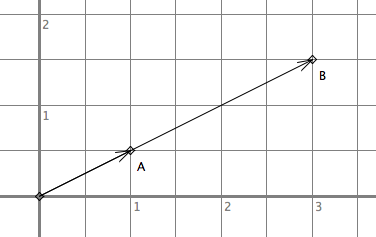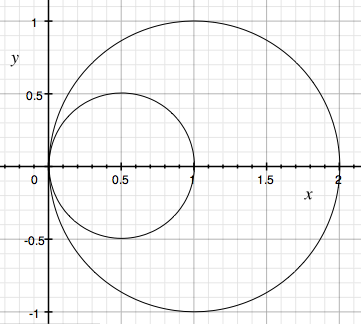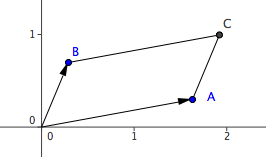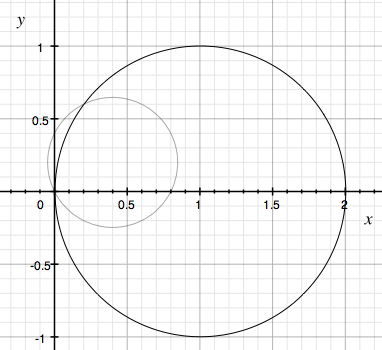Transformations: Scaling, Moving, Rotating a Curve
Vectors
A point {a,b} has a distance to the origin. Also, it makes a angle with the positive x-axis if we consider the line {0,0} to {a,b}. These two concepts are very useful and convenient, that we define the length of a point to be the distance from the origin to the point, and we define the angle of a point to be the angle it makes with the positive x-axis. When a point is considered this way, we call it a vector. We say, that a vector has a length, and a angle.

If a point A has coordinates {a,b}, its length can be expressed as Sqrt[a^2+b^2]. This comes easily from
Pythagorean theorem.
The angle of a vector {a,b} is ArcTan[b/a]. This is from trigonometry
.
Scaling a Vector
Given a vector {a,b}, to scale (dilate/contract) the vector by s around the origin, the new vector is {a,b}*s.

Scaling a Curve
Let
f[x,y]==0
be the equation for a curve in rectangular coordinates.
To scale the curve by s, the new equation would be:
f[x/s, y/s]==0
Let
f[θ,r]==0
be the equation for a curve in polar coordinate.
To scale it by s, the new formula is
f[r/s,θ]==0.
Let
{f[t],g[t]}
be the parametric formula for a curve in rectangular coordinate.
To scale it by s, the new formula is
{f[t],g[t]}*s.
Let
{r[t],φ[θ]}
be the parametric formula for a curve in polar coordinate.
To scale it by s, the new formula is
{r[t]*s,φ[θ]}.
Example

A circle (x-1)^2+y^2-1==0 has center {1,0} and radius 1. To scale it by a factor of 1/2, we replace x by 2*x and y by 2*y, to obtain
(2*x-1)^2+(2*y)^2-1==0.
Translate a Vector
Given a vector {a,b}, to translate the vector by {c,d}, the new vector is {a+c,b+d}.
The adding of coordinate components is a very convenient operation. We define it as vector addition. That is, {a,b}+{c,d} := {a+c,b+d}, and its geometric interpretation is that one vector is moved to a new position by the second vector.

Translate a Curve
Let
f[x,y]==0
be the equation for a curve in rectangular coordinates.
To translate the curve by vector {a,b}, the new equation would be:
f[x-a, y-b]==0.
Let
{f[t],g[t]}
be the parametric formula for a curve in rectangular coordinate.
To translate it by vector {a,b}, the new formula is
{f[t],g[t]} + {a,b}
Rotate a Vector
The point {Cos[α],Sin[α]} is a point with α angle with the positive x-axis and 1 unit distant from the origin. To rotate it by angle β, then new coordinate is {Cos[α+β],Sin[α+β]}. By trig identity of double angle:
Cos[a+b] == Cos[a] Cos[b] - Sin[a] Sin[b]
and
Sin[a+b] = Cos[a] Sin[b] + Cos[b] Sin[a]
, we can then write our rotated point as
{Cos[α] Cos[β] - Sin[α] Sin[β], Cos[α] Sin[β] + Cos[β] Sin[α]}
Now, look at the components in the above coordinate. They are of the form Sin[…] or Cos[…]. In other words, if we have a point A := {Cos[α],Sin[α]} and point B := {Cos[β],Sin[β]}.
Then, the point A rotated by β angles can be written in terms of the coordinate components of A and B.
In other words, if A is {a,b} and B is {c,d} and suppose both are 1 unit distant from the origin, then a new point C, obtained by rotating A by B's angle, can be expressed in terms of coordinate components of A and B by this expression: {a c-b d, a d+b c}.
But now if we substitute a by r*a and b by r*b and c by s*c and d by s*d. In other words, we start with points {r a,r b} which is r distant to the origin, and point {s c,s d} which is s distant. Then, the above formula gives us {r s (a c-b d), r s (a d+b c)}. From this, we can say that length of the new vector is just the product of the lengths of the old vectors.
In summary, if A is {a,b} with angle α and length r, and B is {c,d} with angle β and length s, then {a c-b d, a d+b c} is a point with angle α+β and length r*s.
This formula is extremely powerful, because it lets us do rotation and scaling around the origin at the same time, and by simply using another vector.
Note About Complex Numbers
Note: rotating one vector by another, is exactly how multiplication of 2 complex numbers is defined. You can think of complex number a+b ⅈ as vector {a,b}. The definition of multiplication of 2 complex numbers is exactly the definition of rotating one vector by another. That is, the multplication of complex number a+b ⅈ and c+d ⅈ is defined to be {a c - b d, (a d + b c) ⅈ}. You can see that it's the same as rotation of vectors, expressed by the vector's coordinate components. 〔see Understanding Complex Numbers〕
Rotating a Curve defined by a Equation
Let f[x,y]==0 be the equation for a curve in rectangular coordinates.
Suppose we want to rotate it by a angle θ. First, we find a vector {c,d} of distance 1 having angle -θ, which is {Cos[-θ], Sin[-θ]}. Then, we do this substitution into the function:
x → x c - y d y → x d + y c
so we obtain:
f[x c - y d, x d + y c]
This would be the new curve we wanted. If the vector {c,d} has length r, then the new curve would be dilated by 1/r.
Example

Suppose:
f[x_,y_] := (x-1)^2+y^2-1
Then, f[x,y]==0 is a circle centered on {1,0} with radius 1.
Let's say we want to rotate it by angle θ represented by the vector {2,1}.
So, we should use a vector that has angle -θ, which is {2,-1}.
So, {c,d}:={2,-1}.
Now, we substitute the rotation with our formula
x → x 2 - y (-1) y → x (-1) + y 2
So our new function is:
g[x_,y_] := ((x 2 - y (-1))-1)^2 + ( x (-1) + y 2)^2-1
Then, g[x,y]==0 is our old circle rotated. Note that it is also shrinked. This is because the vector we used {2,-1} has a length greater than 1. If we want to keep the circle the same size, we should use a vector with length 1, which is {Cos[-θ],Sin[-θ]}.
Let
f[r,θ]==0
be the equation for a curve in polar coordinate.
To rotate it by α, the new formula is
f[r,θ-α]==0.
Let
{f[t],g[t]}
be the parametric formula for a curve in rectangular coordinate.
To rotate the curve by θ radian, the new formula is
{Cos[θ]*f[t] - g[t]*Sin[θ], Cos[θ]*g[t] + f[t]*Sin[θ]}
or, if {c,d} is a unit vector with θ radians,
the new rotated curve expressed in terms of {c,d} is
{f[t]*c-g[t]*d, f[t]*d+g[t]*c}.
Let
{r[t],φ[t]}
be the parametric formula for a curve in polar coordinate.
To rotate the curve by θ, the new formula would be:
{r[t],φ[t]+θ}.